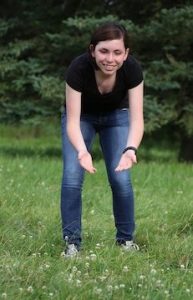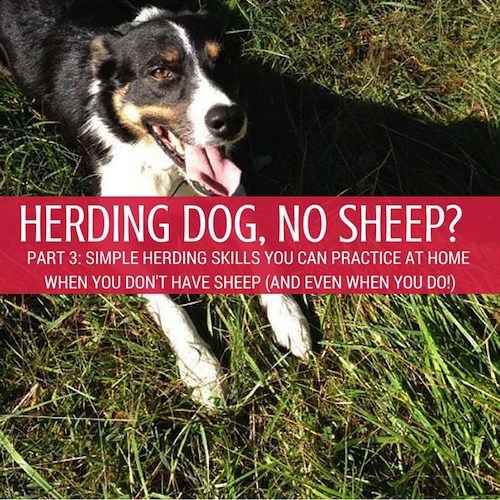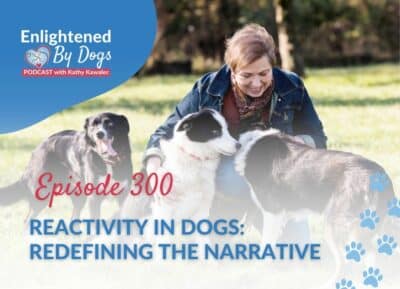3 SIMPLE THINGS YOU CAN PRACTICE AT HOME to accelerate your herding progress.
This is Part 3 of a series…see part 1 and part 2 for some fun games to keep your dog mentally and physically satisfied…and work on important skills!
It can be a challenge to make progress when you can only practice herding once a week or twice a month! But there are LOTS of things that you can do at home that will speed things up, create a partnership with your dog, and build crucial skills that are transferable to herding.
Here are 3 practical herding specific things you can do:
1. Visualize and Actualize: Practice Your Footwork.
One of the best ways to shorten the learning curve when you are learning a new skill is to practice the footwork without your dog.
When you visualize the finished skill, and you physically rehearse the moves you are creating neural pathways and muscle memory that will make a huge difference when you do it ‘for real’.
You’ll want to have a very clear mental image (like a video clip) that you can play in your mind of the desired end result. Your mental movie should include you, your dog and the sheep.
For reference, you can ask your herding coach or a friend who has already mastered the skill to demonstrate for you and video the demo with your phone…or maybe just seeing it will be enough.
You can apply this concept with any lesson you and your dog are currently working on when you do get sheep time.
Let’s say you’re a beginner, and you’re learning how to wear and make turns, while supporting your dog’s flanks and stops at balance…perfect skills to rehearse at home!
I did that for hours and hours when I was a beginner. In fact, I got so good, and my dog and I advanced so quickly, even though we could only practice on sheep twice per month … that the other students where I was training asked ME to teach them the footwork, since the instructor had no clue.
Or, maybe you’re more advanced, and you are learning how to shed with your dog.
There are a lot of details and nuance to this skill…more than meets the initiated eye! In addition to all the steps it takes to train you and your dog…there are the little details about how you move, stand, your posture, your focus … that you can rehearse at home.
Think of these questions to set up your practice for success:
- What are the actual moves that you will be making…what are your feet doing? Your arms?
- Your posture? Your eyes? Your position relative to the sheep, and to the dog? How are you using your presence? I teach something I call “The 3P’s” … a crucial part of understanding your influence on your dog.
- How is your dog responding? How can you adjust and modulate your moves to be more clear? I call this the “Dialog Loop” and teach my students and clients how to be so present that they can actually tap into the brilliance of their dogs and progress through the steps so much more quickly.
If you’re not sure about the steps and all the details, get your coach to break each move down for you…so that you not only understand the “why” but so that you are rehearsing accurately.
I see so many people rehearsing skills incorrectly…which, as you can imagine, really delays progress because you are embedding the wrong thing!
Footwork rehearsal and mental movie visualization is something that I incorporate into each lesson with my herding students and it’s amazing how much quicker they learn and how much better their dogs respond. Try it!
2. Learn a New Language.
Spanish or Chinese anyone? Ok, more seriously, if you and your dog can learn the basics of a new language at home without the distraction of sheep, your progress will increase at 10x the speed! No kidding.
When you start learning herding with your dog, that’s just what is happening ‘behind the scenes’ … a new language for communicating in the context of sheep herding is developing. If you approach this process deliberately, and with mindfulness, you’ll be minimizing the miscommunication that is so common.

I call it “The Dance” because it allows you to communicate crucial moves that will support your dog’s desire to control the sheep…and it’s like a ballroom dance, moving and responding to one another in an attentive and responsive way.
The basic moves are: move in, hold/pause, and move out. Basically, you are sensitizing your dog to be attentive to personal space. Not only is that useful between you and your dog…but it’s crucial between your dog and the sheep, right?
It’s great fun to stay present, using your 3P’s to communicate with your dog and create a dance. First practice with your dog very close to you … then from farther and farther apart.
3. HERDING PARTNERSHIP LANGUAGE: The Next Level.
Now the next thing you can do is use use your Dance and Your 3P’s to rehearse connection, focus and importantly: impulse control.
Gates and Doorways are great places to practice these skills. The idea is that you will NOT (or try not to at first) put your dog in a sit/stay before you release through the gateway or doorway … instead you will teach your dog to be attentive and responsive to your communication.
You’ll want to be very clear, supportive and in a teaching frame of mind as you and your dog learn to interact in this new way.

So, use that amazing ability of your dog by learning what each tiny move you make means to your dog, and to modulate/adjust your 3P’s to get the desired result:
Your dog eagerly waiting for your invitation to come through the gate or door with you…without being ‘on command/cue’. It’s a beautiful thing!
Not only does this practice enhance the communication between you and your dog .. but your skill at staying present, and staying in the dialog loop will quickly expand into mastery!
And that, of course, will help you to read the sheep better, read the situation better, and to have a language with your dog that you are both familiar with when the distractions get high: sheep!






